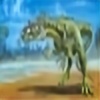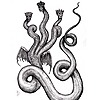HOME | DD
 EvolutionsVoid — Panthelis
EvolutionsVoid — Panthelis

#arthropod #creature #insect #invertebrate #monster
Published: 2018-09-04 02:23:19 +0000 UTC; Views: 3343; Favourites: 106; Downloads: 0
Redirect to original
Description
The Panthelis is a species of wolf-sized predatory invertebrate that lives exclusively in the Underworld. More specifically, the Panthelis can only be found in the Underworld's fungal forests, which I bet you folk didn't know existed! (Unless you read some of my other entries...) Though surface dwellers like to believe that the Underworld is nothing but fire and brimstone, there are actually a wide variety of ecosystems that can be found down below! The fungal forest is a habitat that occurs in massive caverns, where mushrooms and other fungi have grown to titanic proportions. By that I mean mushroom stalks that grow to the size of trees. Huge pillars of fungal flesh that go so high that they practically fuse to the ceiling! And from these columns sprout even more fungi, whose branching forms or slimy shapes give the impression of branches and vines! It's almost like walking through a jungle at night, but everything is made out of mushrooms! It is an extraordinary sight to see! These places are so massive and bountiful that you will forget that you are miles beneath the surface! And since these ecosystems are filled to bursting with fungi, there are a wide variety of species that call these forests home! The Panthelis is one of these, as they quite enjoy the amount of prey species that are lured in by such a buffet!Though I have seen many beasts and critters in my time, I have to say that the Panthelis is one of the weirder looking ones. Just look at that head they have! While many would view that curved, spiky carapace as its face, it is actually more like a rather fancy helmet. The mouth of the Panthelis is actually beneath this giant bladed shield, its mandibles facing downwards. As for eyes, this beast has none. Though the fungal forests possess a large amount of bioluminescence, the Panthelis has chosen to ditch its sight for impressive senses of smell and hearing. This is probably for the best, as the undergrowth of these forests can get quite dense, which makes for a rather small field of vision when combined with the gloominess. The long tangle of antenna that flow from the back of their headpiece are coated in sensitive hairs that can pick up the scent of prey and the vibrations emitted from sound. They even have jointed appendages near their head that sport these hairs, making it easier for them to follow a trail as they barrel their way through the vegetation. What they seek is the sign of prey, be it the sound of a wounded animal or the smell of blood. When their senses pick up a viable trail, the Panthelis will let out a whirring call to alert its compatriots. When it comes to the hunt, the Panthelis never do it alone.
The Panthelis are pack hunters, working in teams of four to five to track prey and take them down. While some may expect there to be a pack leader, the Panthelis do not seem to have one. When one observes their hunting patterns, you will find them moving in perfect formation, each one performing their duty without hardly a sound or signal. These hunting packs can consist of any amount of males or females, though there will often be one female left out during the breeding season as she cares for the young. When a whiff of potential prey is caught, the pack will gather in a V-shaped formation and run to the source. This is when you will see why they possess such strange heads, and you will be quite impressed to see what these crazy things can do!
The first use of their extravagant head shield is when they are chasing down prey. It comes from the curved structures that make it look like a boomerang got stuck through their heads. These wide blades are actually quite sharp, and they can slice through the soft flesh of fungi with ease. As they sprint through the vegetation, the head plate will protect them from obstacles and cut a path through the stalks and strands. With the whole pack running, they can clear quite a trail! You would think a mob of scythe wielding farmers came by! As the pack is running, they will keep their senses out for their target, making sure their meal doesn't slip their notice. When at last they find their prey, they will pick a strategy and take formation. From what has been seen, it is believed that the Panthelis have two major strategies they use when bringing down prey. Which one they pick depends on the creature they are looking to topple. The most common of the two is used when they come across armored prey. Beasts like the Isodon and the Propabis are covered in thick plates that can repel tooth and claw. Any attack on this impenetrable shell would be useless, which makes hunting difficult when your prey is coated in the stuff. The Panthelis know this, so they would never just dive in and try to brute force it. What they also know, however, is that this armor is not everywhere. The tops and sides may be covered, but the underbelly is not. With this knowledge, the pack will take formation as they close in. The two hunters on the outer edges will break off and flank the animal from both sides. The remaining hunters will slow their charge, waiting for the two to catch the prey's attention. The flankers will converge on the beast and aggravate it, swiping at their face and rear with long claws. What they are doing is baiting out a clamp down. Since Isodons and Propabis have thick armor and vulnerable underbellies, they will use their many legs to anchor themselves so that their plates touch the ground. Against most predators, this tactic keeps them from crawling under and removes their major weak point. For Panthelis, it is the one move they are waiting for. When the prey has stopped moving and has locked itself down, the others will join the party. Arranging themselves in a horizontal line, the rest of the hunters will run full speed at the side of the hunkered down animal. They will bring their head plates low so that the bottom spiked lip is almost cutting through the dirt. At full force, the pack will ram into the side of their prey. With their tough carapaces, such an impact hardly effects them, but it will be quite a blow for the victim! This attack is meant to surprise their prey and dislodge some of their legs. Against younger Isodons or Probabis, this initial ramming attack can completely dislodge them and send them tumbling. When up against adults, this merely weakens their hold. This is fine, as the Panthelis are not done yet. As you may have noticed, their head plates have sort of a plow-like shape to them. The ramming hunters will slide this sharp bottom beneath the target's plates and begin to push. With their strong back legs, the Panthelis will try to push forwards and upwards, looking to expose the vulnerable underbelly. While the team tries to pry the creature free, the two flankers will continue their assault. Swipes at the face will keep the prey focused on protecting their head, making it harder for them to resist the dislodging. As prey is slowly peeled up from the ground, the sharp noses of the prying team will slide forward and bite into the flesh. This helps weaken the animal even as they struggle to topple it. If they are capable of pulling it up high enough, the two flankers will dash towards the exposed underbelly and begin to slash and tear. They aim to disembowel the target or at least take it out through blood loss. Even if the prying team doesn't have the strength to hold the target up for the long, the horrible injuries they cause may weaken it enough for them to finish the job later.
If the Panthelis are faced with prey that is not armored, like the Halugyth, they will bust out their other strategy. The pack will spread out to surround the prey, running in circles to keep them pinned down. One by one, the hunters will take turns charging at the target. If the animal is taller than them, they will run at its legs, letting their sharp blades slice at their skin and flesh. If the prey is smaller, they will curve at the last second so that the sides of the head plate cut them. As one runs at the target, the rest will keep out of striking distance and will work to annoy the creature. Their goal is to either cut the legs out from under them or weaken them enough that the pack can converge and finish them off. When their prey drops, they will rush in and use their claws to kill them. Then they shall feast, using their serrated limbs on their belly to carve out pieces to feed to their mandibles. If the pack has young, they shall carrying pieces of the kill back to them and the guardian mother.
For breeding, the strongest female from the pack is the one that will bear the offspring. She shall select the healthiest male, which is often determined by the width of their side blades. When the time comes, she shall lay three to four eggs in a carefully selected spot. What the female is looking for is a very specific species of mushroom, which is known for its foul odor and noxious spores. It seems that the Panthelis are immune to the choking clouds it lets out, so they lay their eggs in clusters of this fungi so that they are safe from predators. Even then, the mother will keep close watch. She will no longer participate in the hunts, instead remaining with the eggs until they hatch. Even when the young do emerge, she shall stay with them and protect them. The mushrooms will continue to aid her and the offspring, as they keep away potential threats. In return, the fungi will get plenty of Panthelis dung from group, as they do not move far from the spot. Honestly, I find this relationship pretty interesting! A predator and a waste-eating mushroom working together!
To the demons and shades that call the Underworld home, the Panthelis are a very situational hazard. While they are indeed a threat to those who traverse the fungal forests, they are incapable of traveling through small tunnels due to their wide heads. Creatures like the False Olm can be a danger in any environment, but these guys are limited to the forests they dwell in. What also helps is the fact that they cannot climb the mushrooms pillars that dominate the forest. Their sharp limbs are too good at slicing through the flesh, so they just slide down whenever they try. When demons and shades travel through these ecosystems, they will climb up on the stalks and make their way atop the branches and nets. If one was foolish enough to walk on the ground, they would risk being targeted by a hungry pack. Demons have the unfortunate problem of being tall, which means the Panthelis will look to cut their legs out from under them. Shades that are not inhabiting a false body can easily lose arms to their blades, eventually being cut down enough for the pack to dive in with claws unsheathed. Though they are dangerous, some hunt these beasts for their claws and famous head plates. The head plate can be carved up into a weapon or shield or even both! As for their meat, it isn't really worth it. It seems they do not give enough flesh for hunters to bother, and even then, it is said that it tastes like copper. The odd thing, though, is that demons will still harvest the meat from killed Panthelis and they will still totally eat it. Valac did that after he finished off a wounded one that we came across during an expedition. As we sat around the fire, he went on about how nasty Panthelis tasted as he proceeded to eat the whole thing. I tried a bite and spat it out, but he just kept going. I didn't have the courage or stupidity to tell him to either stop complaining or stop eating it. If I had, I probably would have become the target of another prank. Besides that, watching a Panthelis pack hunt as we sat atop the fungal stalks was an absolute delight! It was a little tough to see due to the low lighting, but I ate up every second of it! The toughest part was getting up there to begin with, as I am not that great of a climber! I had to awkwardly shimmy up one of the stalks as Vespar climbed behind me and made sure I didn't fall off. I don't know how they did it so easily, as mushroom flesh is not as sturdy as tree bark, and I felt like I slipped farther down than I actually climbed. The nice thing was that I knew Vespar would catch me if I fell, but the bad thing was that I had to deal with Valac constantly cracking wise that me and the fungal pillar should "get a room."
Chlora Myron
Dryad Natural Historian
--------------------------------------------------
The Underworld can always use some more critters, so here is one that is based on the Marrella!
Related content
Comments: 11

👍: 0 ⏩: 1

👍: 0 ⏩: 1

👍: 0 ⏩: 0

Thanks! I was aiming to give them quite the alien look!
👍: 0 ⏩: 0

Like a zergling with expnded armor. 

👍: 0 ⏩: 1

Thanks! With a head like that, it would do well in a zerg rush! Just have them charging with the front lines mowing people down!
👍: 0 ⏩: 0

i love this design! its like an oversized flesh eating trilobite, man thats awesome
👍: 0 ⏩: 1

Thanks! I am really happy with this design! It does kind of have a trilobite look to it, which is funny as the Marrella were once a part of the class Trilobitoidea.
👍: 0 ⏩: 0



















